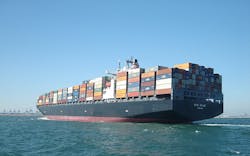Stocking Up for Holidays Boosts October Imports
As merchants are busy getting ready for the holiday season, October is expected to be the second-busiest month of the year, according to the monthly Global Port Tracker report released last week by the National Retail Federation and Hackett Associates.
“The holidays are nearly here, and from warehouses to store shelves, retailers are making sure they have the merchandise on hand to meet consumers’ demands,” NRF Vice President for Supply Chain and Customs Policy Jonathan Gold said.
“November and December are the busiest time for holiday shopping, but this is the month for the behind-the-scenes supply chain work that ensures shoppers will find what they want, where they want it, when they want it,” Gold added.
Ports covered by Global Port Tracker handled 1.71 million Twenty-Foot Equivalent Units in August, the latest month for which after-the-fact numbers are available. That was up 5% from July and up 1.7% from August 2015, and has been the busiest month of the year thus far.
Volume dipped in September to an estimated 1.64 million TEU but was still up 0.9% from last year. October is forecast at 1.65 million TEU, up 6% from last year; November at 1.54 million TEU, up 3.9%, and December at 1.48 million TEU, up 3.4%.
The numbers come as NRF is forecasting $655.8 billion in holiday sales, a 3.6% increase over last year. Cargo volume does not correlate directly to sales because only the number of containers is counted, not the value of the cargo inside. But it nonetheless serves as a barometer of retailers’ expectations, the study said.
The first half of 2016 totaled 9 million TEU, up 1.6% from the same period in 2015.
Cargo volume for 2016 is expected to total 18.6 million TEU, up 2.1% from last year.
Total volume for 2015 was 18.2 million TEU, up 5.4% from 2014.
January 2017 is forecast at 1.53 million TEU, up 2.7% from January 2016, and February is forecast at 1.47 million TEU, down 4.4% from last year.
After a long period of high inventory levels, inventory-to-sales ratio stood at 1.49 in July, the latest number available from the U.S. Census Bureau. That was down from 1.5 in June and a peak of 1.52 in March.
“The inventory-to-sales ratio, one of the best indicators of where the economy is going, is finally declining,” said Hackett Associates founder Ben Hackett.
“It’s not down by much, but the key is that the sharp rise seen earlier this year appears to have come to an end,” Hackett added.
